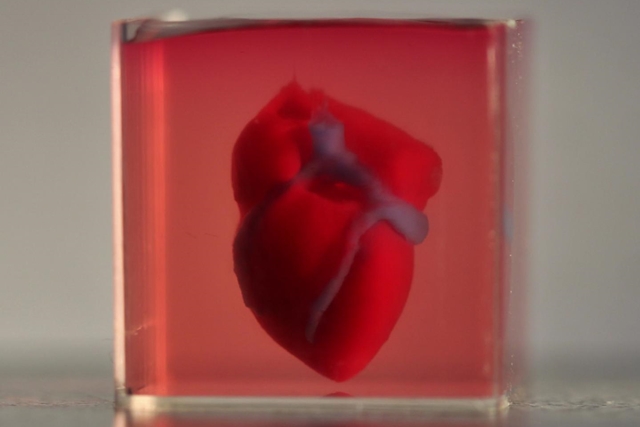
3-D printed, small-scale human heart engineered from the patient’s own materials and cells. (Advanced Science, Tel Aviv University)
16 Apr. 2019. A biomedical engineering team printed a three-dimensional scale model of a human heart, including blood vessels, from cells donated by a living person. Researchers at Tel Aviv University in Israel describe their process in yesterday’s issue of the journal Advanced Science.
The Tel Aviv team from the regenerative medicine lab led by biomedical engineering professor Tal Dvir is seeking longer term treatment options for patients with heart disease. The problem of heart disease is growing as populations in many parts of the world are aging. Heart failure, where the heart cannot pump enough blood to meet the body’s needs, for example, is a condition affecting some 5.7 million people in the U.S., according to Centers for Disease Control and Prevention. For people with end-stage heart failure, a transplant is the only available option, but donated hearts with a close genetic match are often not available.
Printing of cardiac tissue from stem cells is a longer-term alternative to transplants under study, which up to now, is successful in producing pieces of heart muscle tissue. Dvir and colleagues, including doctoral candidate Nadav Noor who led the project, aim to extend that process to a complete heart, including blood vessels, not just pieces of heart muscle. They started with donated cells taken from an individual’s omentum, the tissue surrounding organs in the abdomen that wraps around the intestines.
Those donated cells were then cultured and reprogrammed into pluripotent stem cells, for transformation into precursor cells of heart muscle tissue and blood vessels. The framework for those cells, known as the extracellular matrix, was then extracted and formulated into a hydrogel, a form of water-based polymer. The team produced separate hydrogels for heart muscle tissue and blood vessels, mixing the hydrogel with the extracellular matrix with precursor heart muscle and blood vessel cells, to make bioinks for a 3-D printer.
The researchers used computer models to design the 3-D printed heart, particularly the blood vessel structure. The team first printed pieces of heart muscle tissue under lab conditions, which revealed cells similar to those in living hearts. They then 3-D printed a smaller-scale model of a human heart, about the size of a rabbit’s heart, but with a blood vessel architecture similar to a human heart. The same technology can be used, say the researchers, to print a human-size organ.
A key advantage of this technique is its ability to produce an organ that matches the biological characteristics of the donor. “The biocompatibility of engineered materials is crucial to eliminating the risk of implant rejection, which jeopardizes the success of such treatments,” says Dvir in a university statement. “Here, we can report a simple approach to 3-D printed thick, vascularized and perfusable cardiac tissues that completely match the immunological, cellular, biochemical, and anatomical properties of the patient.”
The team points out that their 3-D printed heart is not yet a working model, the next stage in the project. “We need to develop the printed heart further,” notes Dvir. “The cells need to form a pumping ability. They can currently contract, but we need them to work together.”
More from Science & Enterprise:
- Start-Up Creating Off-the-Shelf Stem Cell Therapies
- Univ. Developing Implanted Islet Cell Bags for Diabetes
- Stem Cell Genes Edited to Avoid Immune Rejection
- Kidney Organoids Created with Working Blood Vessels
- Brain Tissue Model Devised for Cancer Drug Testing
* * *

 RSS - Posts
RSS - Posts
[…] Human Heart 3-D Printed from Patient Cells […]